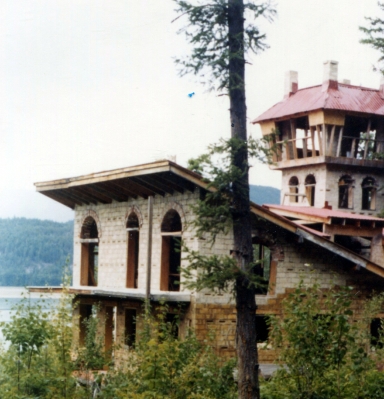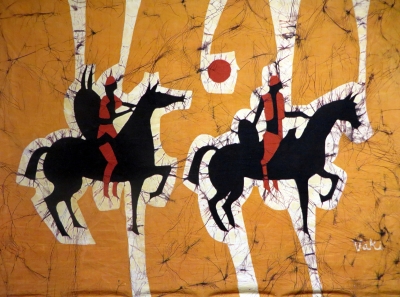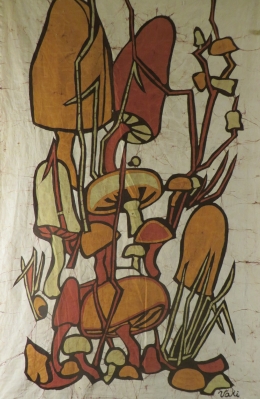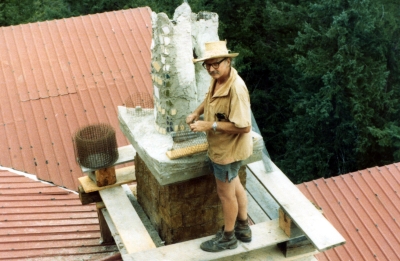William Laux
By Yvette Brend – Arrow Lakes News December 14, 1988
From the Archives of the Arrow Lakes Historical Society
Photos by Peter Klopp
Bill Laux plans nothing.
Forester, Batik artist and sculptor, he builds his talents like he builds his “castle”, adding walls, arched windows and wood stoves to every room. He prefers not to finish.
“When you put the roof on, that’s as high as it’s going to go, and that’s a sad day,” he said. Visitors pass a “Beware of Bats” sign entering Laux’s property, and may notice a strange gnome perched on his chimney. Up the hill, overlooking Arrow Lakes stands his strangest, most imposing creation. Laux began his pet architectural project in 1969. It symbolizes his entire life.
He has varied interest from the daring architecture of Huntertwasser, and copies of Col. R.T. Lowery’s witty editorials to the tiny brown bats that live under the eaves of his “castle.”
Laux has an English degree from the University of Wisconsin, with some chemistry and science background.
“I took English because it gave me the most freedom,” said Laux, “as long as you took one English course, you could take anything else you wanted.”
He worked as a forester in California before moving to Canada, when the U.S. Federal government expropriated his property for a park reserve. He changed countries and then professions. Laux and his wife Adele, bought 100 acres in Fauquier, where he began a batik studio. Laux had no prior artistic experience, but his chemistry background fostered his inventive skills with dyes for fabric.
“I got involved in batik because I was broke – the greatest motivation in the world,” laughed Bill.
The Lauxs moved to B.C. because they loved the valley, and land was very cheap in the interior during the 1960’s.
When B.C. Hydro bought the flood rights to seven acres of Laux’s property he was cautious. Part of his neighbor Logan Bumpus’ land and Laux’s foreshore was flooded. Laux was compensated with a generator to restore his power. He was not disheartened by this event at all, saying it was good luck to be disconnected from B.C. Hydro. Logan Bumpus never regained his power. [They do have power now.]
Adele, Bill’s wife, died suddenly in 1967 from blood poisoning, leaving him alone in Fauquier.
Batik was very stylish in the 1970’s and artists began to gather at Laux’s in the summer to learn the art of waxing and dyeing fabric.
Bill joined with other artists to form Vaki studios – a Tarahumara Mexican Indian word meaning “homestead”.
When Vaki studios started booming it supported five full time artists, who worked during the winter and sold on the road two months of the year.
Laux said it took some time before he felt confident as a designer, he excelled at the chemical mixing of dyes and created new dyes for different effects.
He taught Batik techniques to students until 1975, but now he prefers to create.
Batik is a form of artwork using waxes and dyes to emboss a pattern on a natural fabric – usually high quality cotton.
A negative design is drawn on the fabric with wax resist of different consistencies, then dipped into a dye one color at a time, using yellow first, then ruby red, turquoise-blue to black, and slowly a design is built.
Originally Batik was sold as yardage for clothing. Batikers created a design and made a yard of it for sewing into garments. For this reason many Batik artists had problems as the process was recognized only as craftwork. Crafts have a use; art is created solely for aesthetic value.
Once completed, a batik is identical front and back. Silk screening – the process or printing fabric with oil based ink – does not produce this effect. Hung in a window, in front of a light source, the batik acts like a stained glass window, casting colored light.
“There’s no way to duplicate a batik, except going through the process again,” said Bill.
Different waxes used on the fabrics creates varied effects, a brittle wax creates more of a “crackle” or cracked texture, smoother wax gives an even color. Batiks were in fashion in the 1920’s, and again in the 1960’s, “Oh they’ll come in fashion again. ’ ’ said Laux.
Vaki studios sold at least 80 batiks a year, in British Columbia and along the west coast of the U.S. They produced Westcoast Indian designs, Mexican Indian patterns, Oriental and floral patterns. The artists worked on each other’s ideas, making the operation a co-op studio. Vaki Studios designed an Owl Logo for the Calgary Inn. The Inn only bought one batik of the design, fearing the $90 art work would be damaged if placed in the rooms.
“I would recommend this to anybody, when you go into a hotel, with those awful pictures on the wall, put them under the bed, and I mean leave them there, ” he said emphatically, “ After a while management may get the hint – It’s visual pollution, but nobody says anything.”
“We couldn’t make enough bullfighter stuff in Calgary,” Bill speculated that many rich Calgarians holiday in Mexico, and admired the Mexican styles of their work.
Indian designs were also popular. Art studio refused to handle genuine Indian artists, and their skills remained in tourist booths – carving totem poles and soapstone.
Some of the titles of his pieces were Toro, Witness Tree, Constipated Owl, and Lovers or Madonna and Child.
Through the growth of his studio, Bill also began work on his “castle” in 1968 with fellow artist, gone architect, Lynne Gilroy. “Those happy days are gone. A lot of art outlets in B.C. have gone bankrupt and can’t make it anymore,” laughed Laux. “If I were to hit the California market now, I’d sell them life sized sculptures of their astrological signs.”
So Laux began to spend more time with his prepackaging dye and tool business and his architectural project. He still does some custom work for commercial interiors, such as hotel lobbies and other public buildings.
“When you’re in the art business you have to keep changing. Tastes change.”
Someone gave him the idea of sculpting with steel wool and cement, so he built a strange gnome, which perches on his chimney. After seeing his chimney ornament, a resident of Fauquier commissioned him to create a meteorite-like chimney pot, and two customers, in Seattle and Wenatchee Washington, have also ordered custom sculptures.
Four of his life-sized structures will also be placed on his turret, one for each chimney. He has rigged a pulley system to hoist the heavy pieces into position.
Laux’s castle can be viewed from his small two level cabin and studio, lower on the property. The ominous structure faces the lake with turrets, endless chimneys and white-framed windows.
“We didn’t draw any plans, we just let it keep growing,” said Bill.
Entering the house, a geyser spurts water on its left – perhaps for a fountain? Bill prefers to leave it to the imagination.
The house has three main levels and countless smaller rooms on varying levels. The main turret has three levels, one planned as Laux’s bedroom, with a small hatch door on the floor to close off the world.
Laux said he learned “rude carpentry” from his experience as a forester and experimented from there.
Two of the chimney statues are in place. They are naked females, one with flowing golden hair. The third, a nude Indian with spear is almost finished, and the fourth is still in Laux’s imagination.
From the turret another chimney topped by an abstract chimney pot, made of old dishes, mirrors and brown clay, can be viewed.
The tower also presents a seemingly endless view of the Arrow Lakes. “The higher we
went, the better the view got,” he said.
Downstairs, past verandas and window frames hand sculpted with Poly filler, the basement floor is heated by a huge log burning stove, and contains Laux mini sawmill he uses to cut the lumber for building. The bathroom and kitchen should be finished by next year, when Laux may move in.
Bill picked up a tiny bat, dead from exposure, on his ornate windowsill, and gently examined it.
“I don’t plan, I never have planned, because when I plan something, I always change it.”




Pingback: Breaking the Code – Part I | The Peter and Gertrud Klopp Family Project
Pingback: STEEP AND CROOKED … by Late Writer, Artist & Castle Builder Bill Laux – Chapter 1 | The Peter and Gertrud Klopp Family Project
I love the distinction between art and craft. When I taught copyright law, that was an important distinction because US copyright law does not protect the design of “useful articles” unless the art can be separated either physically or conceptually from the useful aspects of the article. With something like batik, the images would be considered conceptually separable since the cloth need not have any images in order to work as cloth. So this was a fascinating definition of the difference to me as the retired law prof!
LikeLiked by 1 person
Thank you for the clearly written explanation of the distinction between art and craft as it applies to US copyright law. Have a great Sunday, Amy!
LikeLiked by 1 person
Thanks for sharing this fascinating story. I love and have purchased several batiks. I love that he simply created without planning some of his castles and pieces. How else does one really learn? By doing of course. What stories of Canada too. Lovely. Much appreciated.
LikeLiked by 1 person
I photographed a Vaki batik early this year 2019 with the idea of looking into it. I am a weaver/textile artist and writer with a focus on Canadain Textile and fibre art, craft, and history, and this site was the first thing that popped up when I googled Vaki. I am a believer in getting stories about artists down and in front of art historians so they can’t just dismiss makers, not in their official histories. I was very happy to have found this “Story” Batik has a bad time in Art History as weaving does Thank you for your family history funny how artists come from families, not just schools.
LikeLiked by 1 person
I am constantly amazed how the Internet can be so helpful when it comes to digging up information. I am glad that you found the article on Bill Laux and his studio Vaki useful.
LikeLike